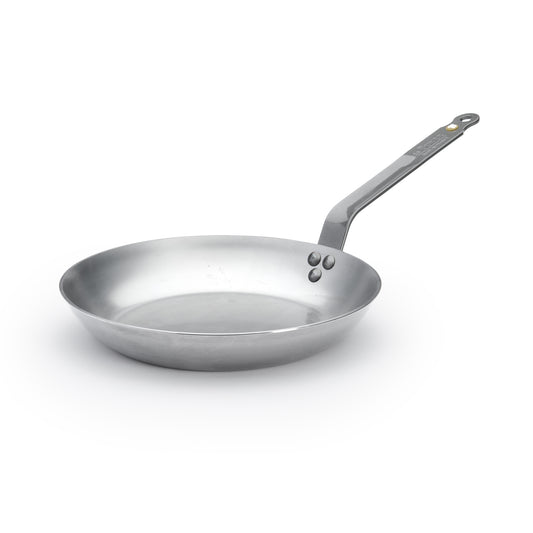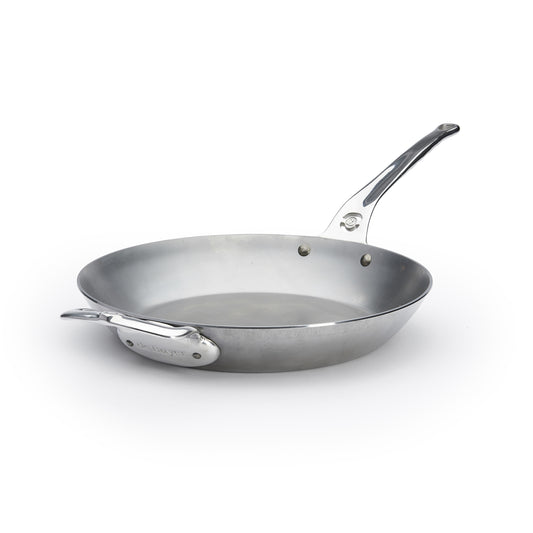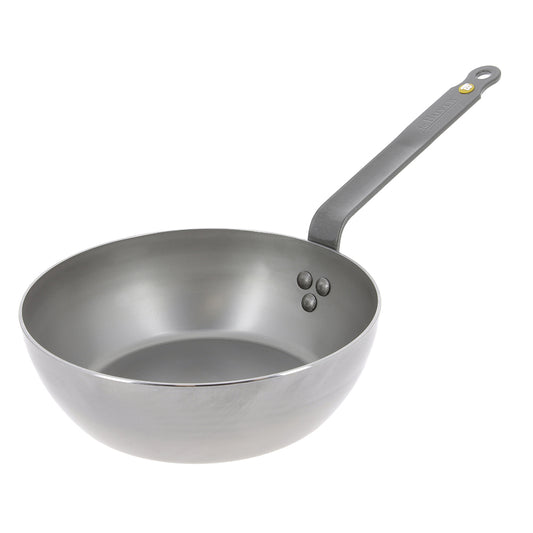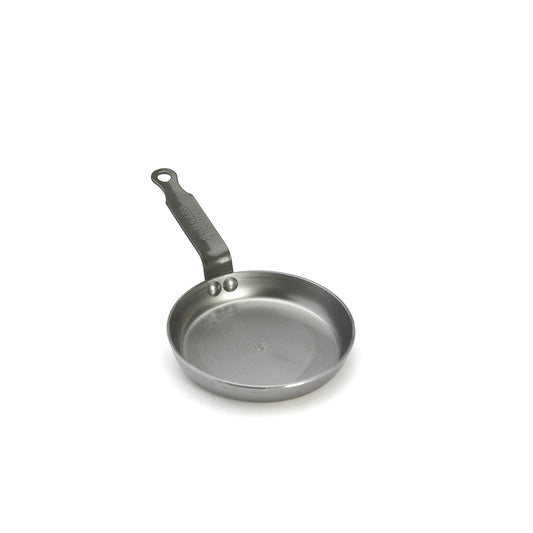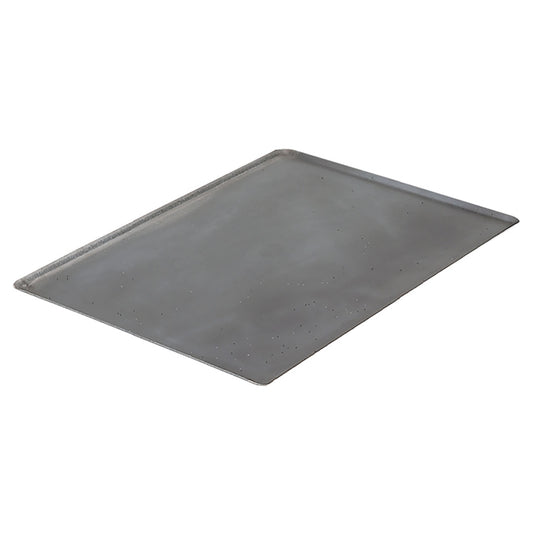Enhancing Your Culinary Craft: What Is Cookware?
What is cookware, really? Explore the essential tools and premier materials for your kitchen and learn about their ideal uses for various cooking styles.
de Buyer

Cookware is the vehicle for crafting delicious French crepes, American sliders, and complex German strudel. After the cooking method and ingredient quality, the types of pots and pans you use make the most impact on the outcome of your dish.
Here, we provide a comprehensive resource that explores the types of cookware available, the characteristics of cookware material, and the important difference between cookware and kitchenware. (They're not the same thing.)
Discover the best cookware for your needs and arm your kitchen with the right tools.
What Is Cookware?
Simply defined, cookware is the instrument used in the cooking of your food, typically made of copper, steel (stainless or carbon), or cast iron, and the main pieces of cookware are pots and pans.
Essentially, the food rests in the cookware and is usually heated, so all cookware must have high heat conductivity and even heat distribution/retention properties. Some tools that are classified as cookware are simultaneously bakeware.
Bakeware is a tool for preparing foods using dry heat (an oven). All baking is considered cooking, but not all cooking is considered baking; therefore, there is overlap in the classification of these pots and pans.
Regardless of what you’re making, your cookware must be made with quality materials, and it’s important to select the right material for the job. A cast iron skillet is not a great substitute for a Dutch oven when it’s time to make a stew.
Cookware vs. Kitchenware
We’ve covered cookware and bakeware, which only leaves kitchenware to the imagination. Kitchen utensils like offset spatulas, tongs, and ladles are kitchenware. Some people consider dinnerware like plates and cutlery to be kitchenware as well.
Chefs need both cookware and kitchenware to craft most dishes, making both vital components of a functional kitchen.
Types of Cookware: Essential Kitchen Tools
Every type of cookware has its place, from nonstick frying pans to stainless steel woks. Discover the essential materials that make up the best cookware.
Stainless Steel Cookware
Stainless steel cookware is a sleek and attractive option, but these pans don’t just get by on their looks. They’re a popular choice due to their strength, rust resistance, and precise heat control.
Made from iron, chromium, and nickel, stainless steel tools are durable and versatile. They won’t react with alkaline or acidic foods, and their steady heat conductivity ensures even cooking. However, it's important to avoid overheating to prevent food from sticking.
Keep in mind that the quality of stainless steel cookware can vary. Higher-end options often feature three—and five-ply layers that resist warping and easily withstand high temperatures. Proper care and the use of appropriate cleaning products are essential to maintaining its longevity.
Many cooks prefer stainless steel stockpots and roasting pans due to their natural anti-warp characteristics. Plus, their denting-resistant structure makes them solid heavy-duty cookware items.
Cast Iron Cookware
Cast iron is a classic cooking material made of iron, carbon, and silicon, along with some other trace metals. These pots and pans are excellent at heat retention and are a staple of the quintessential kitchen.
These cookware pieces require the most maintenance and are the heaviest. The maintenance comes from the upkeep of the patina, otherwise known as the season. Cooking acidic foods in a cast iron pan can lead to corrosion and damage to the patina.
Still, cast iron is a champion at the long simmer, a staple of steak preparation, and a solid option for slow cooking any meat.
Carbon Steel Cookware
Carbon steel is functionally the merger of a stainless steel pan and a cast-iron skillet. It delivers superior heat conductivity, durability, and a natural non-stick surface. It’s lighter than cast iron and, just like cast iron, carbon steel cookware requires seasoning.
If you’ve purchased a de Buyer carbon steel pan, then you’ll first need to remove the beeswax coating that protects against rust. Simply hand wash using hot water and a gentle brush. Next, you can season in one of two ways.
- Oven Season: Apply a thin layer of neutral oil, and preheat the oven to around 450°F. Place the pan in the oven for an hour, then let it cool. This method is suitable for Oven-Safe Mineral B PRO and Blue Carbon Steel collections.
- Stovetop Season: Apply a very thin layer of oil, then heat the pan on medium-high until it smokes and turns dark brown. Once cooled, wipe off excess oil. This process can be repeated a few times.
After this, your patina will continue to develop and strengthen, assuming you maintain it and avoid using it with acidic foods. A carbon steel pan will give you an excellent sear every single time, and its cooking surface only gets better with age. Carbon steel is a must-have nonstick cookware item.
Copper Cookware
When it comes to thermal conductivity, copper cookware is the champion. This material responds quickly and evenly to your heat source, making it uniquely suitable for quick stir-frying or boiling water.
De Buyer’s PRIMA MATERA copper line is a high-performance option that responds incredibly well to all cooktops, including induction. With copper, you get an even cook every single time. Copper, just like stainless steel, doesn’t necessarily require seasoning; however, neither has a non-stick coating. If used correctly, both cookware materials can function like they’re non-stick, though.
Copper cookware will need to be maintained. We recommend de Buyer’s Copper Cleaner and a proper non-invasive cleaning routine.
Choosing the Right Tool for the Job
Selecting the best cookware for your kitchen can revolutionize your kitchen experience. Use our chart to help you choose the right tool for your culinary needs.
|
Stainless Steel |
Cast Iron |
Carbon Steel |
Copper |
|
|
Durability |
About as durable as carbon steel |
A solid mid-durability option |
About as durable as stainless steel |
Slightly less durable than the steel options |
|
Heat Conductivity |
Offers good heat conductivity, well suited to a simmer |
Excellent heat retention |
Excellent heat retention |
The best heat conductor among the four |
|
Maintenance |
Lowest maintenance, requiring only proper cleaning |
Requires regular seasoning to maintain patina |
Requires regular seasoning to maintain patina |
Requires regular polishing/gentle cleaning |
|
Cooking Performance |
Versatile and suitable for a wide range of cooking methods |
Perfect for slow cooking, but not always ideal for quick cooking due to its slower heat response |
Excellent for high-heat cooking methods like searing and stir-frying |
Best for quick, delicate cooking |
|
Best Suited For |
Great for everyday cooking and versatile tasks |
Perfect for slow-cooked dishes, steaks, and hearty meals |
Ideal for high-heat cooking, searing, and stir-frying |
Excellent for precise, fast cooking |
Cookware Essentials: Must-Have Tools for Every Kitchen
There are key cookware pieces that every chef or cooking enthusiast should consider. The ultimate goal is to build a practical kitchen that’s both versatile and functional.
We recommend starting with seven premium pieces and diversifying from there:
As you expand your kitchen, consider items like pressure cookers and griddles to expand your repertoire. Use your new knowledge of cookware materials, cooking utensils, and essential items to build a kitchen that works for you.
Expand Your Culinary Horizons with de Buyer
Your culinary success depends on the right cookware. A versatile kitchen with the best materials for the job will make crafting a delicious meal that much easier.
Explore de Buyer's range of high-quality cookware options for professional and home kitchens. Our superior products have been made in France since 1830. We use our decades of experience to deliver exceptional products made with the best, sustainably sourced materials. Learn more and explore de Buyer’s options today.Learn More
Recommended for You
-
MINERAL B PRO Carbon Steel Fry Pan
Regular price $90.00Regular priceUnit price / per$0.00Sale price $90.00 -
MINERAL B Classic Carbon Steel Fry Pan
Regular price $60.00Regular priceUnit price / per -
MINERAL B Carbon Steel Omelette Pan
Regular price $65.00Regular priceUnit price / per -
MINERAL B PRO Carbon Steel Omelette Pan
Regular price $105.00Regular priceUnit price / per -
Protective Sleeve for Pan Handle
Regular price $9.95Regular priceUnit price / per -
MINERAL B Carbon Steel Crepe & Tortilla Pan
Regular price $70.00Regular priceUnit price / per -
MINERAL B PRO Carbon Steel Fry Pan with Helper Handle
Regular price $145.00Regular priceUnit price / per -
Blue Carbon Steel Fry Pan
Regular price $45.00Regular priceUnit price / per -
Blue Carbon Steel Crepe & Tortilla Pan
Regular price $25.00Regular priceUnit price / per -
MINERAL B Carbon Steel Country Fry Pan
Regular price $100.00Regular priceUnit price / per -
MINERAL B Carbon Steel Egg & Pancake Pan
Regular price $35.00Regular priceUnit price / per -
Blue Carbon Steel Rectangular Baking Sheet
Regular price $35.00Regular priceUnit price / per













